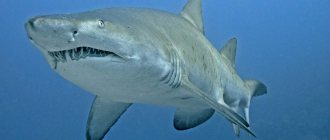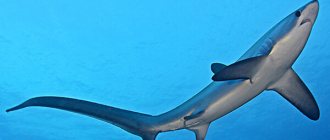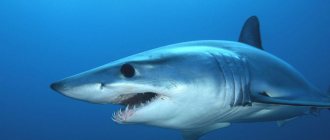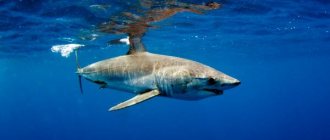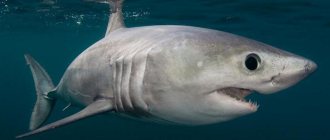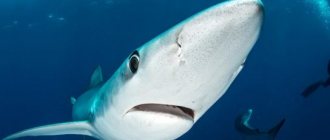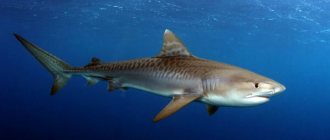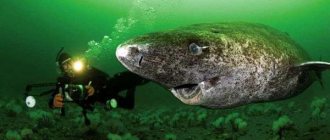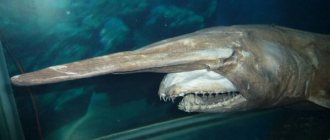The longfin shark (Carcharhinus longimanus, also known as longfin shark, longfin shark, oceanic whitetip shark, etc.) is part of the gray shark family and genus of the same name. This is a fairly large pelagic predator, reaching 3.5-4 meters in length.
The long-fin shark has two large, rounded pectoral fins at the ends, which give it its name.
The large first dorsal fin is also rounded. The body shape is streamlined, torpedo-shaped.
The long-winged shark is an excellent swimmer with graceful plasticity. The teeth are quite powerful and very sharp, partly having jagged saw-tooth edges. An excellent sense of smell allows them to detect prey over long distances.
Where does the longfin shark live?
The long-finned shark is distributed in the tropics and subtropics throughout the World Ocean. In its biology, it resembles a blue shark, but, unlike the latter, it prefers much warmer water, with a temperature of at least 18 degrees.
Therefore, the range of the two predators partially overlaps, they can even act in joint schools (in this case, the longfin shark is usually dominant over the blue shark).
However, in cooler temperate waters this tropical species is extremely rare. For example, in the Eastern Atlantic, longfin sharks are usually not found north of Spain, without swimming to the latitudes of the Bay of Biscay.
They also do not appear in the Mediterranean Sea, so familiar to their less heat-loving relatives.
Watch video - Longfin shark:
Long-winged sharks, like blue sharks, hunt mainly schooling fish (mackerel, tuna, mackerel, herring) and squid. However, they prefer larger types of prey.
For example, one of their favorite “dishes” is tuna. Such tastes cause considerable damage to fishing. There are known cases when long-finned sharks destroyed up to 20% of the catch, devouring tuna directly on fishing lines.
True, at the same time, the hunters themselves often fall into the traps. However, their meat does not have good taste. The only items that are valued are the fins used for delicacy soup and, to a much lesser extent, the skin and liver of the shark.
Therefore, often caught sharks are simply thrown back into the sea, after having their long fins cut off.
In addition to hunting sea inhabitants, longfin sharks are not averse to eating food waste. They often follow ships for quite a long time, feeding almost exclusively on waste from the ship's galleys. At the same time, they greedily rush to pieces that are thrown to them from the side.
Taking advantage of this behavior, sailors often catch long-finned sharks. The predators that got on board demonstrate high survivability. Sometimes gutted sharks, being thrown back into the sea, continue to swim after the ship and even swallow the hooks again.
Description
Mako is the closest relative of the white shark, famous for its bloodthirstiness and gluttony. The length of the specimen reaches 3.5 m, with a weight of more than 350 kg. The head of individuals is conical, proportional to the body. The back of the mako is dark, with gray and bluish shades predominating.
avatars.mds.yandex.net
The mako's body shape is elongated, streamlined, vaguely reminiscent of a torpedo. Thanks to this feature, specimens are unsurpassed hunters; they can chase prey for a long time and constantly maintain a speed of 35 km/h.
Thanks to the flexible scales on the body, the shark feels the flow of water well and navigates it even when it is cloudy. In addition to speed, the specimens are distinguished by their developed maneuverability; it takes them a second to turn in the other direction.
The incisors, which look like daggers, are worthy of special consideration. They are very strong and can easily crush bones into tiny pieces. The predator tenaciously grabs the victim, leaving it no chance to escape. The mako eats its prey differently from the white shark; it does not tear it apart, but calmly swallows it whole.
How dangerous are longtip sharks for humans?
The longtip shark is a typical inhabitant of the open ocean. Unlike most other representatives of the genus Carcharhinus, this predator practically does not appear near the coast. However, his rare visits to famous resorts can make a lot of noise in the media.
Many may remember the story of 2010 with the closure of beaches in the Egyptian Sharm El-Sheikh. The culprit of attacks on vacationers, as a result of which Russian and Ukrainian tourists lost their arms, was then a long-finned shark.
However, such cases are still the exception. Not because the longtip shark is not aggressive, but because its usual habitat is the open waters of the ocean.
That is why there are not so many recorded cases of this dangerous predator attacking humans.
Watch the video - Longimanus attacks a person:
It seems that if she had the habit of looking more often into the tidal zones of the seas, the statistics of attacks would be much more pessimistic.
The famous oceanographer Jacques-Yves Cousteau generally believed that the long-finned shark is the most dangerous of all types of predators. And the inventor of scuba gear, who spent his entire life exploring the underwater world and its inhabitants, had an excellent understanding of such issues.
Habitat
This shark prefers warm water. It is found in the Pacific, Atlantic and Indian Oceans. The temperature that is comfortable for her is +16 degrees. An individual swims to northern latitudes if its favorite delicacy, swordfish, is found there. Very dangerous for humans in the coastal zone. She does not hesitate to attack and leaves no chance to escape.
Mako is a desirable trophy for an experienced fisherman. But it's not about the size at all. It is not so easy to catch a mako; he will resist to the last and will make unprecedented efforts. Fishing is fraught with risk if the fisherman loses his vigilance for a moment, allowing the shark to grab his flesh with its teeth like daggers.
uposter.ru
Notes
- Life of animals. Volume 4. Lancelets. Cyclostomes. Cartilaginous fish. Bony fishes / ed. , ch. ed. . — 2nd ed. - M.: Education, 1983. - P. 38. - 575 p.
- Lindberg, G.U.,
Dictionary of the names of marine commercial fish of the world fauna. - Leningrad: Science, 1980. - P. 39. - 562 p. - , Kotlyar A. N., , Shatunovsky M. I.
Five-language dictionary of animal names. Fish. Latin, Russian, English, German, French. / under the general editorship of academician. . - M.: Rus. lang., 1989. - P. 31. - 12,500 copies. — ISBN 5-200-00237-0. - ↑ (English). .
- ↑
- . Retrieved March 13, 2015.
- ↑ Compagno, Leonard JV
// FAO species catalogue. - Rome: Food and Agricultural Organization of the United Nations, 1984. - Vol. 4. Sharks of the World: An Annotated and Illustrated Catalog of Shark Species Known to Date. — P. 455–457. — ISBN 92-5-101383-7. - ↑ Cathleen Bester.
. Florida Museum of Natural History. Retrieved March 15, 2014. - ↑ Martin, R. Aidan.
. Elasmo Research. Retrieved March 5, 2014. - Stafford-Deitsch, Jeremy.
Shark: A Photographer's Story. - Sierra Club Books, 1988. - ISBN 0871567334. - Benchley, Peter.
Shark Trouble. - Random House, 2002. - 208 p. — ISBN 0375508244. - Marin
A. ReefQuest Center for Shark Research. Retrieved April 16, 2015. - Savelyev S.V., Chernikov V.P.
The long-winged shark
Carcharhinus longimanus
can use the air sense of smell to search for food // Questions of Ichthyology. - 1994. - T. 34, No. 2. - P. 219-225. - ↑ Animal Life / Ed. V. E. Sokolova. — 2nd ed. - M.: Education, 1983. - T. 4. - P. 38.
- . New Zealand Government (27 September 2012). Retrieved March 16, 2015.
- HF Mollet.
. Retrieved March 16, 2015. - Cousteau, Jacques-Yves & Cousteau, Philippe.
The Shark: Splendid Savage of the Sea. - Doubleday & Company, Inc, 1970. - Cousteau J.-I., Cousteau F.
So that there are no secrets in the sea. Underwater research J.-I. Cousteau. Per. from English - M.: “Mysl”, 1974. - P. 191. - ↑
- . Flmnh.ufl.edu (February 19, 2013). Retrieved March 5, 2014.
Blue-gray shark
Where does the name Mako come from?
Necklaces and earrings with mako shark teeth were a traditional outfit in the Maori culture, the indigenous people of New Zealand. "Mako" is a Maori word that can mean "shark" or "shark tooth". It is unknown whether longfin makos are found in New Zealand waters, but common makos are definitely present here.
Each age has its own: what haircuts will suit ladies by age 30, 40, 50, 60
We're not the only ones who train cats: scientists have discovered why they meow
Detergent: scientists reveal how you can use coffee grounds
Makos help predict election outcome
Researchers at Nova Southeastern University in Fort Lauderdale, Florida, are using GPS to track mako sharks. In anticipation of the presidential election, they decided to conduct an experiment and predict the outcome of the race using two makos, one of which was named Trump and the other Clinton. The winner would be the one with the shark's name on it that would swim the longest distance between September 26 and November 1. Coincidence or not, the mako named after Trump swam 140 miles more.
How do you feel about sharks?
Found a violation? Report content
The largest shark in history - 15-18 meters in length, weight - 47 tons
To the question of what is the largest shark in the world, science currently gives a confident answer - a large whale shark. But it was not always so.
About 20 million years ago, a predator appeared in the world, about which films are still made and books are written. Its name is megalodon (Otodus megalodon, formerly known as Carcharodon or Carcharocles megalodon). For 13 million years, the huge shark dominated other life in the oceans until it went extinct just 2.6 million years ago during global cooling.
Scientists suggest that the largest megalodon specimens grew up to 18 meters in length. For comparison: the length of the largest snake in the world reaches 14.8 meters.
Estimates of megalodon body size are based on the size of the animal's teeth, which can reach up to 18 cm in length. In fact, the word megalodon simply means “big tooth.” It is curious that megalodon teeth have been found on all continents except Antarctica.
This giant shark fed on whales and large fish, and possibly other sharks. Its jaw measured 2.7 by 3.4 meters and was large enough to swallow two adults side by side.
The bite force of a human is about 1,317 Newtons (N), while the bite force of a great white shark is 18,211N. Megalodon bite forces ranged from 108,514 to 182,201N.
What did Megalodon look like?
Most reconstructions show megalodon to resemble a great white shark. But scientists say this is not true.
Megalodon likely had a much shorter nose compared to the great white shark and a more flattened jaw. It had very long pectoral fins to support its gigantic weight and size.
And the ancestor of the modern great white shark lived next to the megalodon. Some shark researchers believe they might even compete with each other.
Protection and status of the species
Previously, there was fishing for mako. Its teeth, jaws and skin were considered valuable. The person did not eat meat. Today, fish are the goal of sport fishing. The shark is caught quite actively, which is why its numbers are steadily declining.
In 2007, the mako was listed as a threatened species, but to no avail. Most countries did not approve a fishing ban, and numbers continued to decline.
In 2022, the species acquired endangered status and appeared in the Red Book. But only a few countries have tightened the fishing ban.
animalreader.ru
Why should the mako be protected, since it poses a threat to humans and the fishing industry? Everything is very simple - sharks are orderlies, they destroy sick and damaged fish, and contribute to the preservation of the ecosystem.
Makos have an interesting structure and behavior that is very different from other species. They are considered the most aggressive sharks. Another thing is surprising: even such a powerful predator could be destroyed by man. Fishing for the purpose of self-gratification has led to the fact that the shark is on the verge of extinction. Today, measures are being taken to protect the species, but whether they will yield results is unknown.
Who do you think is the most dangerous predator in our time? Leave your answers in the comments, and share the link to this work with your friends on social networks.

